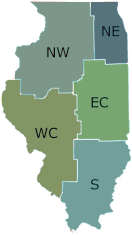The IDNR Bartlett Regional Office is closed to the public at this time. The park remains open.
When people think of a state park, they often imagine significant or unique natural features that warrant the need to be protected for posterity. First-time visitors to James "Pate" Philip (formerly Tri-County) State Park may initially wonder what the area's specific feature is. After all, the land is predominantly farmland that had been tilled and grazed for years.
The north branch of Brewester Creek flows through the property, but most of the streambed had been channeled to move water away from former agricultural fields. Along the north boundary of James "Pate" Philip State Park, starting in the east, a row of houses rises up like a wall against a sea of grasses. Further west along the boundary is an active gravel pit and by the Bartlett Park District sport field. To the west of the park, across Route 25, is a landfill in the process of being closed.
The significance of James "Pate" Philip State Park clearly appears after taking a closer look. First, the mere fact that this amount of land is preserved and protected from further development is significant. This land adds to the large block of open space to the south, which currently is preserved as the 3,432 acre Pratt's Wayne Woods Forest Preserve.
Together, both spaces significantly improve the integrity of the natural processes throughout the region, providing corridors that facilitate animal movement and seed dispersal. In addition, this area enables breeding populations of animals, such as sandhill cranes, herons and Blanding's turtles, to find undisturbed habitat to raise their offspring. And with any large block of preserved land, there is a potential for a higher diversity of animals and plants to exist, meaning more species to participate in the food web and water cycle.
Second, this land contains the remnants of one of the most diverse natural systems that ever graced the Illinois landscape, the tall grass prairie and its associated communities. Hidden among the overused landscape are pieces of a puzzle that represent what once was a rich tapestry of life. A remnant wetland managed to survive in the center of this park and is home to an Illinois endangered species, the dwarf bur reed. This plant alone warranted listing this wetland as an Illinois Wetland Reserve in 1990.
History
The goal of James "Pate" Philip State Park is to preserve these remnant pieces and to restore the ecosystems in order to support the highest possible level of biodiversity. Beginning in 1991, the state of Illinois developed the James "Pate" Philip State Park Restoration Plan which guided the initial restoration of the native landscape. Significant portions of the park already have been seeded to prairie. Prescribed burns were introduced to contain woody growth encroaching on the prairie environment. In addition, drainage tiles along the east boundary were exposed and broken slowing the water flow from the park and collecting in pools. By resaturating the soil, wet prairies and marshes will develop, creating habitat for many species of plants and animals, such as the dwarf bur reed, Blanding's turtle, yellow-headed blackbird and migrating waterfowl.
The Illinois Department of Natural Resources has chosen to locate their Region II offices in the southeast corner of the park. In conjunction with this office, the state constructed the James "Pate" Philip State Park Visitor Center, which opened in December of 2002 and is operated by the Bartlett Park District. This unique partnership allows restoration and education to proceed hand-in-hand.
As people visit James "Pate" Philip State Park for the first time, they should remember that the story of this land is not completely told in what it is now but what this land will become. As the land recovers, the plant and animal life that once flourished throughout the area will return as well. Outdoor enthusiasts are encouraged to come back often and to watch this land transform itself into a functioning, diverse natural area.
Northeastern Illinois
2050 W. Stearns Road
Bartlett
60103
41.978
-88.257


